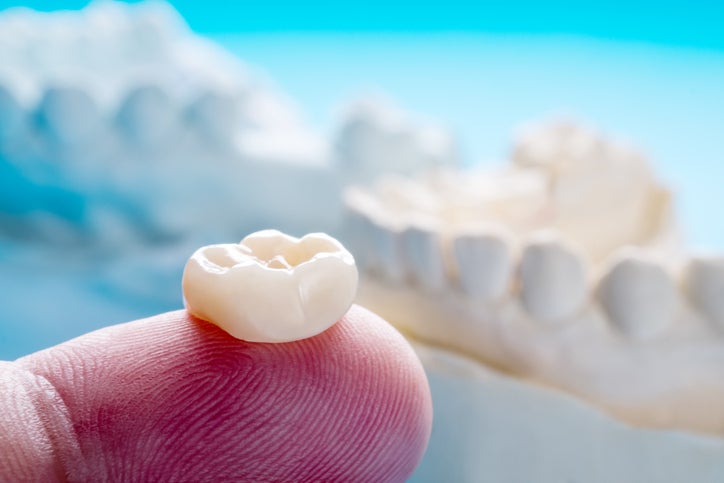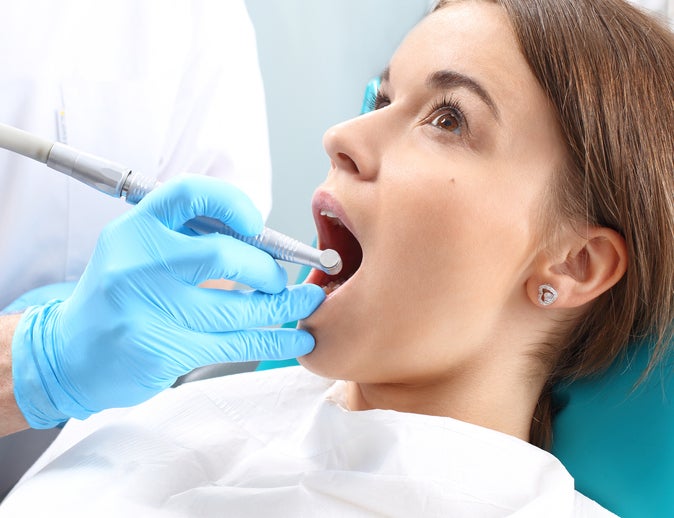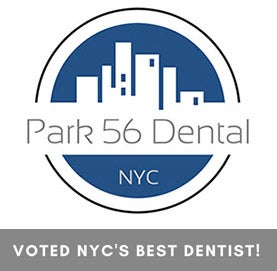-
What Do I Do If My Crown Comes Off?

Many Americans have one or more dental crowns. This restorative dentistry option gives you back your smile after a tooth has been damaged by decay or traumatic injury. While crowns are meant to be permanent additions to your mouth—either cemented on top of a natural tooth or screwed into a receiving hole on a dental implant—they do sometimes come loose. Here’s what you should do if your crown falls off.
Retrieve the Dental Crown
Once you realize your dental crown is missing, act quickly to resolve the issue. First, locate the crown. If it’s still in your mouth, take it out. If it fell on the ground, try to find it. If you swallowed the crown, don’t panic—you will simply need to be fitted with a new one.
Inspect & Clean the Crown
Assuming you have located it, rinse off the crown with warm water and examine the interior side closely. If the crown looks completely hollow or has a small metal rod emerging from it, you might be able to temporarily place it back in your mouth before visiting the dentist for a more permanent solution.
However, if you see part of your tooth stuck within the crown, this means it didn’t lose adhesion—rather, your tooth has deteriorated further and broken off. In this case, you should not attempt to place the crown back in your mouth. Instead, put it in a safe place, such as a small container or plastic bag, until you can meet with your dentist.
Protect Your Tooth
Crowns are intended to shield the underlying structures of a damaged tooth. This means nerves and other sensitive tissues may now be exposed, causing sensitivity to touch and temperature. You may be able to find dental cement at a pharmacy to temporarily replace the crown until you can visit the dentist. Even if you lost the crown or can’t reattach it, you can protect the exposed tooth by molding dental cement or wax around it.
Then, be careful about what you eat. To avoid potentially dislodging the crown again, avoid crunchy, chewy, or tough foods. Steer clear of hot and cold foods as well if they cause you pain. Limit yourself to things like applesauce, pudding, and room-temperature soup until you have a more permanent solution.
Call Your Dentist
Let your dentist know about your emergency without delay. Explain what happened, and make an appointment to repair your tooth immediately —on the same day, if possible. Trust your dentist to pursue the best course of action, which may include putting in a filling, reattaching the old crown, or making a new one.
If your crown has come off, or you have another dental emergency, please contact Park 56 Dental at (212) 826-2322 to request a same-day appointment with our NYC dentist. Rest assured that we’re following all recommended safety precautions from the CDC to keep our patients safe during the COVID-19 outbreak.
-
How to Reduce Dental Pain from a Broken Tooth

A broken tooth can happen in an instant. All it takes is a forceful impact to the face or biting down wrong on a cavity or filling. Whatever the cause may be, you need an emergency dentist visit to set things right. Give us a call at (212) 826-2322 immediately to schedule a same-day appointment with our NYC dentist. In the meantime, reduce the pain from your broken tooth with these tips.
- Take anti-inflammatory medicine: Controlling inflammation is critical for reducing pain from a broken tooth. Over-the-counter anti-inflammatories—such as ibuprofen, acetaminophen, or naproxen—provide temporary pain relief. Just remember that these medicines do nothing to address the underlying issue, so you still need to visit a dentist as soon as possible.
- Rinse with salt water: Salt is an antiseptic and anti-inflammatory, making it the perfect substance for a natural mouth rinse. Pour a cup of warm water into a glass and stir in 1/2 teaspoon of salt. Swish the rinse around in your mouth for 10 to 15 seconds, and then spit it out. Repeat this process four to five times a day until you can visit a dentist.
- Apply a cold compress: Cold temperatures make blood vessels constrict, numbing the pain and reducing the swelling from a broken tooth. Wrap a bag of ice or frozen peas with a towel and place it on your cheek for 20 minutes at a time. Repeat every few hours.
- Chew on garlic: The anti-bacterial and pain-relieving properties of garlic make it an effective remedy for toothaches. Crush a clove of garlic into a paste, add a dash of salt for good measure, and spread it on your broken tooth.
- Numb the pain with peppermint tea: Brew a cup of peppermint tea and add ice to cool it down. Then, swish the tea around in your mouth. You can also freeze the used tea bag for a few minutes and place it directly on your aching tooth.
- Apply clove oil: Clove essential oil contains eugenol, a natural antiseptic that numbs pain and reduces inflammation. Moisten a cotton swab with clove oil and then add a drop or two of olive oil to dilute it slightly. Rub the swab on the affected area a few times throughout the day. Alternatively, you can concoct an antiseptic mouthwash with 1/2 cup water and a drop of clove oil.
- Apply vanilla extract: The antioxidant properties of vanilla extract make it an effective healing agent. It also contains alcohol, which numbs the pain. Moisten a cotton swab with vanilla extract and apply it to the affected area a few times daily.
If you have a broken tooth or other dental emergency, contact Park 56 Dental at (212) 826-2322 to request a same-day appointment. Save the broken-off part of your tooth, if possible, so we can attempt to repair it. Rest assured that we’re following all recommended safety precautions from the CDC to keep our patients safe during the COVID-19 outbreak.
-
What Constitutes a Dental Emergency?

As part of the effort to curb the spread of COVID-19, the American Dental Association (ADA) has provided dentists and patients with guidance on what to consider a dental emergency during the pandemic outbreak. This is a follow-up to the recommendation that patients should postpone elective procedures for the time being.
Here are some examples of what constitutes a dental emergency. If you are experiencing any of these problems, please call Park 56 Dental at (212) 826-2322. We would be happy to assist you and schedule a same-day appointment to have your emergency treated.
Knocked-Out Tooth
If you lose a tooth after getting hit in the face, gently place the tooth back in its socket, being careful to handle it as little as possible. Bite down slightly on moistened gauze to help hold the dislodged tooth in position.
If you can’t get the tooth back in your mouth, place it in a small container of milk or saliva (not water) to keep it moist. Then, call your dentist immediately. The faster you act, the better chance you have of saving the knocked-out tooth.
Loose Permanent Tooth
A wiggly permanent tooth is considered a dental emergency, even if there’s no pain. Hold the tooth in its proper position, and then bite down gently to keep it from moving. You can prevent the tooth from falling out entirely, but you must see a dentist as soon as possible.
Chipped, Cracked, or Broken Tooth
If a tiny corner of your tooth chips off, and you feel no pain, this usually doesn’t constitute a dental emergency. Simply be careful not to let any sharp edges of the tooth cut your lips, cheeks, or tongue
However, if you have a badly chipped, cracked, or broken tooth, this is a serious cause for concern. You may be in severe pain, so call your dentist immediately for an emergency appointment. In the meantime, dull the pain and reduce inflammation with a cold compress to your cheek. Taking anti-inflammatory medicine, such as ibuprofen, acetaminophen, or naproxen, may help as well. You can also rinse your mouth with saltwater for antiseptic benefits.
Soft Tissue Injury & Resulting Pain
Puncture wounds, cuts, or tears to the cheeks, lips, or tongue are examples of soft tissue injuries that can cause pain and bleeding. Clean the area with warm water, and staunch the flow of blood with a soft cloth or gauze pad if available. Then, set up an emergency appointment with your dentist.
Other Dental Emergencies
In short, you should call your dentist immediately if you have any of these symptoms:
- Uncontrolled bleeding
- Severe pain
- Swelling or trauma to facial bones that potentially compromises your airway
- Bulging, swollen, or knotted gums
If you have a dental emergency, contact Park 56 Dental at (212) 826-2322 to request a same-day appointment with our NYC dentist. Rest assured that we’re following all recommended safety precautions from the CDC to keep our patients safe during the COVID-19 outbreak.
-
What is a Root Canal and What are the Signs that you Need One

You’ve probably heard of a root canal, because they’re referenced when people are talking about something difficult or painful, and they pop up in dental jokes. Do you know what the term means? While you may be under the impression that a root canal is a form of torture, it is actually a special procedure that’s relatively simple and can often save a tooth.
The term “root canal” actually means two things. It may refer to the part of the tooth between the pulp and the roots. More commonly, it’s a reference to the dental procedure used to relieve root canal pain by removing infected material. Nerves and blood vessels are contained in the root canals of teeth, and by removing a nerve in an infected tooth, a dentist can eliminate pain caused by infection or decay in the pulp. While many people assume that the root canal procedure is painful, it’s rarely more painful than a filling. The time leading up to the root canal, however, can cause a great deal of pain, stemming from several different causes.
- Tooth decay penetrating the teeth can cause root canal pain.
- Cracks or chips that damage the teeth can also be painful.
- Disease in your mouth may cause decay or infection, compelling your dentist to recommend a root canal.
If you are experiencing extreme tooth pain when you eat, or sensitivity to hot and cold that lingers after you’ve removed whatever was hot or cold, you may need a root canal. Other signs that a root canal may be required include a small, pimple-like bump on the gums, darkening of the tooth, or tenderness or swelling in the gums near the painful tooth. If these symptoms are familiar, it may be time to talk to your dentist about a root canal.
Root canals are highly effective, and many teeth fixed using root canal therapy can last a lifetime. The procedure has a success rate higher than 95 percent and involves several steps.
- First, the dentist takes an x-ray to determine exactly how much damage exists.
- A local anesthetic will numb the area to prevent pain, and a rubber dam will be placed around the tooth to keep it dry.
- The dentist will drill an access hole into the tooth and remove the damaged tissue and nerve.
- After the infected material is removed, the tooth may be sealed or given a temporary filling.
- To complete the tooth restoration, a crown or filling is placed.
At Park 56 Dental Group, we offer pediatric, prosthodontics, endodontics, oral surgery, Invisalign®, emergency, and sedation dentistry, all at the highest level of treatment. We serve the Midtown, Central Park, Upper East Side, Park Avenue, and all surrounding Manhattan and New York areas, with a patient-centered practice that has hours to fit your schedule. Schedule your complimentary consultation today by contacting us online or calling us at (212) 826-2322.
RECENT POSTS
categories
- Uncategorized
- Cosmetic Dentistry
- Veneers
- Healthier Teeth
- Teeth Whitening
- Dental Health
- Video
- Dental Emergencies
- Invisalign
- Dental Implants
- Root Canal
- Sedation Dentistry
- Infographic
- Dental Crowns and Bridges
- Dental Anxiety
- Gum Disease
- COVID-19
- Bad Breath
- New York Dentist
- Cut out sugar
- General Dentistry
- Oral Health
- Oral Cancer
- Dry Mouth
- Gum Health
- Toothache
- Dental Sealants
- Cavities
